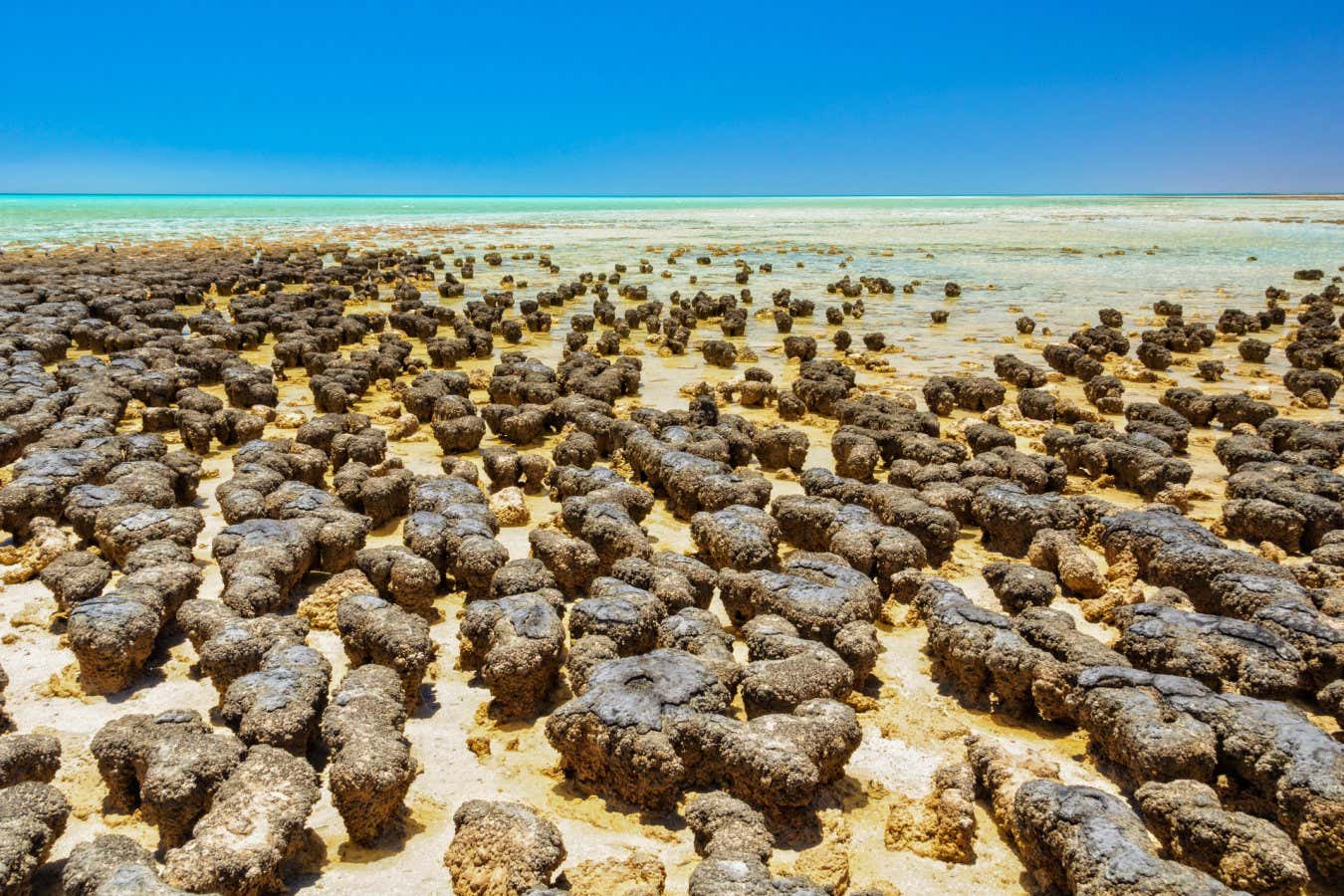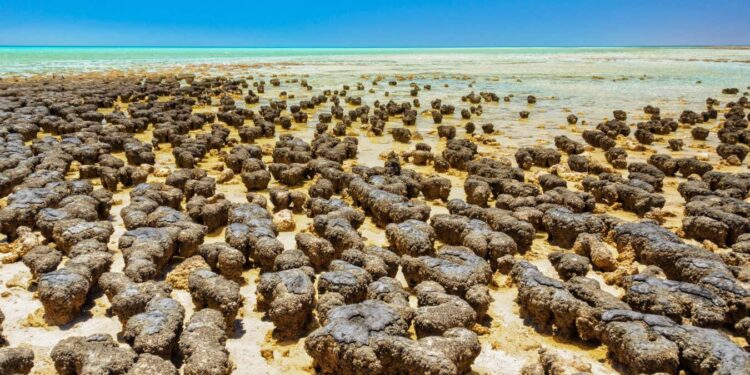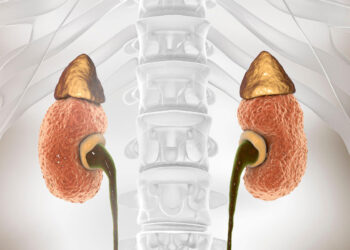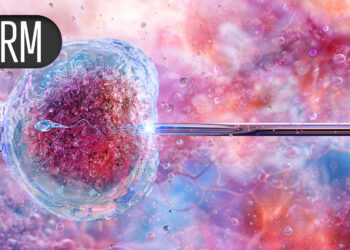
Stromatolites are rock-like structures formed by bacteria in shallow water
lkonya/Shutterstock
Microbes from a remote bay in Western Australia seem to connect to each other with tiny tubes, forming a relationship that may reflect an early step in the evolution of complex life.
In Shark Bay, or Gathaagudu in the Indigenous Malgana language, microbes form slimy multi-layered communities called microbial mats. It is a harsh environment battered by tides and temperature swings, but these communities of bacteria and another kind of single-celled organism called archaea have survived here for tens of thousands of years. They often live in symbiosis with each other, building up their communities into layered sedimentary formations called stromatolites.
“The mats form in hyper-saline conditions with high UV levels. They get hit with cyclones. Pretty much everything seems to smash these things but they still seem to hang around,” says Brendan Burns at the University of New South Wales in Sydney.
They are modern analogues of how communities of microbes may have been living together billions of years ago when complex life first evolved, he says. This is theorised to have happened when bacteria and archaea became so mutually dependent on one another that the bacteria ended up living inside the archaea, creating more complex cells known as eukaryotes.
Burns and his colleagues brought some of these microbial mat communities back to their lab and tried growing the organisms in high-salt, low-oxygen conditions.
They ended up with a culture of just one species of bacteria, Stromatodesulfovibrio nilemahensis, and a newly named archaeon, Nerearchaeum marumarumayae, from a group called the Asgard archaea. These archaea are named after the home of the gods in Norse mythology and are thought to be the closest living relatives of eukaryotic cells, which make up our bodies and those of other animals and plants.
“Those organisms seem to be directly interacting with each other and swapping nutrients,” says team member Iain Duggin at the University of Technology Sydney. The team doesn’t have direct evidence for that, but they do have complete genome sequences, which allow them to infer how the metabolisms of both organisms work.
The sequencing showed that the bacterium makes amino acids and vitamins, and the archaeon produces hydrogen and compounds such as acetate, formate and sulphite. Both sets of products aren’t made by the other species but would be needed by them.
The researchers also saw hints that the two species were directly interacting. “What we did observe is what we’re calling nanotubes,” says Duggin. “Little tubes that seem to be made by the bacterium and connect directly to the outside of the Asgard cell.”

3D reconstruction based on electron microscope images showing the cell membranes of an archaeon (blue) and a bacterium (green), with nanotubes (pink) between the two
Dr Matthew D Johnson, Bindusmita Paul, Doulin C Shepherd et al.
In what may have been part of the cooperation, the archaeon cells produced chains of vesicles, sac-like structures that cells use to transport molecules, attached by extracellular fibres. Duggin says the little vesicles from the archaeon seem to be interacting with the nanotubes generated by the bacterium.
“The nanotubules may be too thin to be conduits, but they could help bind the cells together in a sort of multicellular union that enables them to better share resources,” says Duggin.
The researchers also found genome sequences that code for proteins that have never been seen before, and one protein that is about 5500 amino acids long, which is very large for an archaeal species, that bears similarities to proteins in human muscles. “I’m not making the assumption that it’s a human muscle protein, but it suggests that the evolution of those proteins could have started a very long time ago,” says team member Kate Michie at the University of New South Wales.
“What I find most interesting are these direct connections by nanotubes between the bacteria and the archaea,” says Puri López-García at the University of Paris-Saclay in France. “This has not been observed in previous cultures.”
However, it is hard to know what the bacteria and archaea are actually doing, says Buzz Baum at the MRC Laboratory of Molecular Biology in Cambridge, UK. “Bacteria and archaea are at war and peace with each other,” he says. “They’re touching each other, sharing, fighting and who knows what’s going on.”
Duggin thinks that in this case it is more likely to be peace than war. “Because these organisms have sort of ended up together in our cultures after four or more years, we think they don’t mind each other’s company and probably get on pretty well,” he says.
Burns and his colleagues propose that what they have seen may reflect an early step in the evolution of eukaryotic cells on microbial mats, which Roland Hatzenpichler at Montana State University says might be possible.
“The study’s results show that the newly found Asgard archaea directly interact with sulphate-reducing bacteria, which could provide a driving force to a much closer – and ultimately possibly obligate [dependent] – interaction,” he says.
This might not be what happened more than 2 billion years ago, though, says López-García. “These are modern archaea and modern bacteria, although the microbial muds they live in can be considered analogues of some past ecosystems.”
We might never know to what extent modern microbes resemble the cells that partnered up to form the proto-eukaryotic cell, says Hatzenpichler. “But we are now in a better position than ever to approach the truth.”

Arctic marine biology expedition cruise: Svalbard, Norway
Embark on an unforgettable marine expedition to the Arctic, accompanied by marine biologist Russell Arnott.
Topics:
Source link : https://www.newscientist.com/article/2492751-weird-microbial-partnership-shows-how-complex-life-may-have-evolved/?utm_campaign=RSS%7CNSNS&utm_source=NSNS&utm_medium=RSS&utm_content=home
Author :
Publish date : 2025-08-15 16:00:00
Copyright for syndicated content belongs to the linked Source.











